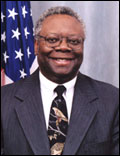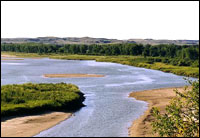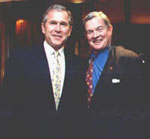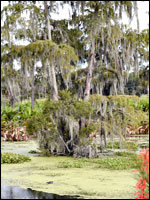
Craig Manson.
Photo: USFWS.
In the final days of October, Craig Manson, assistant Interior secretary for fish and wildlife and parks, dealt a “Godfather”-style blow to a team of government biologists that was about to release a final report with flow recommendations for the Missouri River — a blow that could have a sizable ripple effect on the river itself. The report was to have argued for the need to better mimic the natural flow of the Missouri (releasing more water from hydroelectric dams in the spring and less in the summer) to prevent extinction of the river’s endangered sturgeon, tern, and plover populations, and to reduce the risk of future flooding.
Responding to objections from the U.S. Army Corps of Engineers that the report’s suggestions would economically inconvenience dam owners and the Missouri River’s barge industry, Manson penned a three-paragraph memo ordering a second opinion on Missouri River management. [Click here to download the memo.] This opinion is to be provided by a “special national team of [U.S. Fish and Wildlife] Service experts … referred to as ‘the Wise Guys’ or the ‘SWAT Team,’ [which] has served well in other complex, high-interest consultations,'” he wrote, with nary a trace of irony to soften the mafia-boss language. The replacement biological SWAT team will reach its conclusions after a 45-day study; the original team’s findings were based on more than 10 years of research and were confirmed by independent peer review as well as by the National Academy of Sciences.
Those original findings were also upheld last year by a federal court: When the Corps refused to adopt the flow-change recommendations made by the team in 2000, the environmental group American Rivers took the agency to court and won. Still, the Corps has only partially complied, and is now arguing that river conditions have changed since 2000 and that the science is unreliable: “Our [most recent] engineering studies have demonstrated that the proposed flow changes will not achieve desired biological attributes,” said Paul Johnston, a spokesperson for the Corps.
Johnston argued that mating habitat for river life should be created by bulldozers, not river flows: “We can build sandbars mechanically for mating habitat that tremendous flows [as well as commercial cost] would be required to accomplish naturally.” Johnston estimated that the commercial cost of implementing the scientists’ recommendations would be $30 million in lost annual hydroelectric plant revenue; in addition, the barge industry would face losses resulting from shutting down operations for up to two months of the year.

The Big Muddy.
Photo: USGS.
But the ecological costs of not adopting the recommendations are potentially far more calamitous. “Keep in mind that these are engineers talking about biology,” said Allyn Sapa, a recently retired biologist with the U.S. Fish and Wildlife Service who supervised the Missouri River project for more than five years. “They don’t seem to understand that right now we are pushing three species toward the brink of extinction and the current water-flow operations are violating the Endangered Species Act. It seems that the [engineers and the Bush administration] don’t want to hear that. And it’s hard not to think that because our findings don’t match up with what they want to hear, they are putting a new team on the job who will give them what they want.”
A scientist on the disbanded team who is still employed at Fish and Wildlife spoke to Muckraker on condition of anonymity: “What concerns me is not just that the officials seem to be looking for a predetermined answer [on how to manage river flow], but that the replacement ‘SWAT team’ scientists know almost nothing about the Missouri River — whereas our team has worked in this river basin for years.”
Equally calamitous could be the long-term political costs of jettisoning sound science to curry favor with industry, said Eric Eckl, director of media affairs for American Rivers. “This is just the latest chapter in a politically complicated book called ‘War and Peace over the Missouri River.'” The central villain in this novel, said Eckl, is Sen. Kit Bond (R-Mo.), a strong supporter of the barge industry who seems convinced that any kind of environmental protections for the river will sabotage his state’s economy. His paranoia has been swallowed whole by the Bush administration: In August, President Bush attended a fundraiser for Bond and declared that no federal agency should govern the flow of the longest river in America.

Bush bonds with Bond.
Photo: USGS.
There are reasons why Bush may find Bond so convincing: While Missouri is hardly the only state with a claim on the eponymous river, which runs from Montana to the Mississippi River, it is a swing state with more electoral votes than any other in the river’s path. And Bush doesn’t need to worry about those other states from a campaign standpoint, as most are solidly Republican.
From a legal and scientific standpoint, however, he might well have to worry. The fish and wildlife agencies of all seven states along the river have written in support of the original team’s findings. American Rivers said that if the new team reaches pro-industry conclusions, it’s more than prepared to go back to court. Senate Minority Leader Tom Daschle (D-S.D.) has also publicly questioned the administration’s move and is teaming up with other river-basin senators to call for an investigation into the Bush administration’s decision to sack the scientists. “For over 10 years, the U.S. Fish and Wildlife Service has been saying that the science is on our side, but now the Bush administration seems to want different scientists to reach different conclusions,” Daschle said in a statement. As we’ve seen before, this administration’s M.O. is simple: If you don’t like the science, change the scientist.
Slippery When Wetland
That same motto could have been scrawled atop a resignation notice submitted in late October by Bruce Boler, a former U.S. EPA scientist in Florida who quit in protest when the agency accepted a study concluding that wetlands can produce more pollution than they filter. “It’s a blatant reversal of traditional scientific findings that wetlands naturally purify water,” Boler told Muckraker. “Wetlands are often referred to as nature’s kidneys. Most self-respecting scientists will tell you that, and yet [private] developers and officials [at the Corps] wanted me to support their position that wetlands are, literally, a pollution source.”

A murky outlook for swamps.
Why? So that Florida developers could fill in the wetlands to make golf courses (which use enough fertilizer and pesticides to make them among the highest-polluting forms of development). Boler’s scientific judgment that wetlands were not pollution sources but pollution filters — a judgment based on 25 years of research — would not have stopped big-budget golf courses and other projects from going forward, but it would have forced developers to clean up all pollution runoff generated by their projects. By contrast, a finding that wetlands are actually pollution sources would decrease the cleanup burden (and the price tag) for developers.
“Developers were really upset with my findings and protested vehemently to the state and the [Corps], saying that we did not have the authority to raise these objections to their proposed high-dollar developments, some of which spanned nearly 2,000 acres and included many million-dollar homes,” Boler said.
The Corps was upset with Boler’s science, too — so much so that John Hall, chief of its regulatory division in Jacksonville (which is responsible for issuing developer permits), “began referring to me as a ‘loose cannon,’ and during one meeting slammed down a two-foot-long cannon replica on the conference table to dramatize [this nickname] for me,” Boler said.
Not surprisingly, a developer put a different scientist on the job to come up with an alternative finding that traces nitrogen and phosphate to wetlands themselves — a conclusion that the EPA eventually accepted. It’s true that isolated wetlands do emit trace amounts of nitrogen and phosphate due to the natural decomposition of plant material in their runoff, but according to Boler, it’s absurd to think that these natural toxins compare even remotely in either quantity or toxicity to the nitrogen and phosphate that come from artificial developments. But the replacement scientist found a way to prove just that: “The conclusions [developed by the new scientist] were skewed because he got his data from water-quality samples that were collected in wetlands or ponds next to roads and bridges where surrounding developments discharge pollutants,” Boler said.
According to Jeff Ruch, executive director of Public Employees for Environmental Responsibility, the rate of replacing scientists in government agencies has been unusually high during the Bush administration. “There is always one major development or another that can’t go forward without scientific evaluation,” said Ruch, “and increasingly the scientific expert on which those developments hinge is twisting in the wind. If the scientist gives the inconvenient answer they commit career suicide, and if they give the convenient answer they get promoted.”
Boler clearly didn’t get promoted, but he did land another job at the Interior Department, working at Everglades National Park. In a strange twist, the man who ultimately oversees the National Park System is one Craig Manson. When Muckraker spoke with Boler, he hadn’t heard about the fate of the Missouri scientists, but Ruch had: “He may be jumping from the frying pan into the fire.”
Gag Me With a Memo
Last month, Muckraker correctly predicted that the U.S. EPA would eventually drop the backlog of cases against power plants that had violated the New Source Review rules of the Clean Air Act (which the Bush administration gutted earlier this year), thereby allowing the utility industry to avoid an estimated $10 billion to $20 billion of investments in new pollution-filtration technologies. What we didn’t predict was that the EPA would try to muzzle its employees shortly before announcing that it would drop the investigations. The agency barred employees from talking not just to the media and the public, but also to congressional staff members and state and local government officials about the status of enforcement investigations or information related to enforcement actions.
The gag order was issued in an Oct. 28 memo signed by Assistant EPA Administrator John Peter Suarez and leaked to the staff of the Clean Air Trust. [Click here to download the memo.] The four-page memo pays lip service to the need to “continue to work openly, fairly, and in accordance with all legal requirements,” but its real message lies in the list of those to whom EPA employees shouldn’t speak, another list of topics they shouldn’t touch, and an exhortation to protect “sensitive and confidential information.”
“This memo starkly demonstrates that those government officials evoking the courage to make the administration’s anti-clean air policies public are operating in an extraordinarily difficult, if not hostile, working environment,” said Frank O’Donnell, director of the trust.
Worse, that memo could make it difficult for states to prosecute these investigations in the EPA’s stead, said O’Donnell, as it blatantly prohibits staff from talking to representatives of state or local governments that don’t enter into a joint prosecution agreement with the feds. The memo, however, does not seem to be intimidating the attorneys general of New York, New Jersey, and Connecticut, who say they are more than ready to take matters into their own hands and pick up the dropped cases against the polluting plants.


